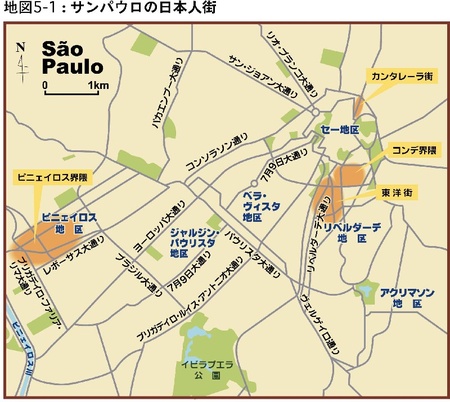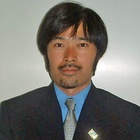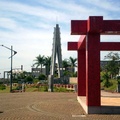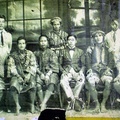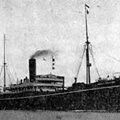In and around São Paulo city, there are many areas referred to as “Japantowns.” Before and after World War II, the area known as the “Conde District” was the largest of the Japantowns. The Pinheiros Region followed in Nikkei population with around 200 Nikkei residents (Hanada, 1970, p.573). And after that, the area around the Municipal Central Market, which was named “Cantareira-gai” after the street (Reference Map 5-1).
The Pinheiros District is around 7km from the city center and from long ago, functioned as an inn town along the highway towards Sorocaba and Paraná. From the 19th century, it became an important position for supplying the western area of the city with agricultural products. In particular, the Pinheiros market was an important location for distributing batata (potatoes) and feijão (beans), produced by small Nikkei farms, to the São Paulo suburbs toward Cotia. The following passage describes Pinheiros Market in those times.
The market was established under the Albuquerque government in 1910. At the time, many referred to the market as “The Caipira Market” because of the numerous small farmers and peasants gathering from Cotia, Una, Piedade, M’boy, Itapecerica da Serra, Carapicuíba, etc. (Cotia Sangyo Kumiai Chuokai Kanko Iinkai [Cotia Central Industrial Association Publication Committee], 1987, p.16).
What triggered the formation of a Japantown in the Pinheiros District was the construction of the Cotia Industrial Association warehouse. The Pinheiros Market, referenced above, was reported to have numerous problems. “At the time, the market had already been filled with Nikkei produce. However, when it rained, at least half of the produce would get wet, causing the market price to heavily decrease. There were times when the price would fluctuate 23 mil 500 in a day and 42 mil in a week’s time” (Previous Reference, p.16). And so, there arose an “absolute necessity” to build a warehouse in the area. Further, the Nikkei farmers needed to unite in order to protect their livelihoods against trouble with fertilizer products and brokers.
Beginning with Cotia in December of 1927, and followed by other Nikkei potato farmers of agricultural towns around São Paulo such as Jaguaré and Morro Grande, the “Limited Responsibility Union of Potato Farmers in Cotia” was established. It was the beginning of South America’s largest agricultural union. Because the headquarters and warehouse of this union was located in the Pinheiros District, Nikkei businesses such as general stores, restaurants, and ryokan (Japanese style inns) began to open their doors in the area. By 1933, Pinheiros’ first association, the Pinheiros Youth Association, was established. In the same year, a judo hall named Shobukan was built (ACEP, 2005, p.18). Nikkei residences grew towards the center of town along Cardeal Arcoverde Street, Teodoro Sampaio Street, and Pinheiros Street.
Though I have already mentioned the Nikkei education system strongly influenced by dekasegi ideology at the time, the existence of an ethnic, mother tongue educational institution was a key factor in the creation of a Japantown. Gyousei Gakuen (Gyousei Academy), founded by Kōichi Kishimoto on Rua Consolação near the center of town, was newly established on Rua Miguel Isasa in the Pinheiros District with a new school building and dormitory (Gyousei Gakuen Account, 1939, p.17). Along with a full-day school system and dormitory, the academy also operated a laundry called “Tinturaria Aurora.” The school created a system called the “Kinro-bu” in which Nikkei students who could not afford the tuition could work at this laundry while attending classes in the evenings. Further, Taisho Shogakko (Taisho Elementary School) established a branch in Pinheiros in 1983, in which classes were taught by Mr. and Mrs. Tanaka, who moved there from Bastos of inland São Paulo (ACEP, 2005, p.20).
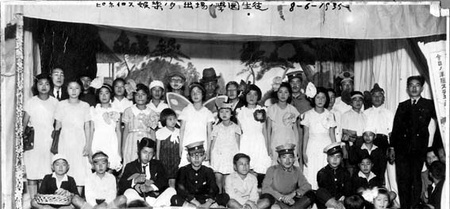
Foto 5-1: Crianças e alunos que participaram da “tarde de entretenimento em Pinheiros” (1935, foto oferecida pelo Sr. Isaku Kishimoto).
After the war, the charismatic leader of Bairro Oriental (Oriental neighborhood), Tsuyoshi Mizumoto, also began his career as an enterprising man in Pinheiros. Mizumoto studied hard while working in the Kinro-bu at Gyosei Gakuen and was advised by Kishimoto to go to São Paulo. After his independence, he worked in the cleaning industry in order to accumulate funds, and in 1948, opened his first general store called “Casa Mizumoto” on Cardeal Arcoverde Street with his brother. Further, the Ikesaki brothers, who would later become leading members in the establishment of Bairro Oriental, also opened the Ikesaki firm in the area, prior to moving to Galvão Bueno Street, which is now in the center of Bairro Oriental.
Compared to the desolate condition of the Conde District during the eviction orders of the war, the Pinheiros District became an important location for the Nikkei after the war. At the time, companies which would later play an important role in the founding of Bairro Oriental, such as Casa Mizumoto and the Ikesaki firm, held their headquarters in Pinheiros. The Liberdade shop, which was established in the 1950s, was positioned as a branch store or an antenna shop. In 1950, Taisho Elementary School branch was reinvented as a Nikkei societal club called “Clube Piratininga” and still exists today. Looking at a map (AMARAL, 1985, p.78) titled, “Coletividade Nipo-Brasilieira de Pinheiro: Distribuicao das Residencia em 1962 (Disposition of Nikkei Brazilians in Pinheiros: Distribution of Residences in 1962),” one can easily see that in the first half of the 1960s, there were a considerable number of Nikkei residences in the area (Reference Map 5-2). This prospering Japantown of Pinheiros is said to have continued until the 1970s.
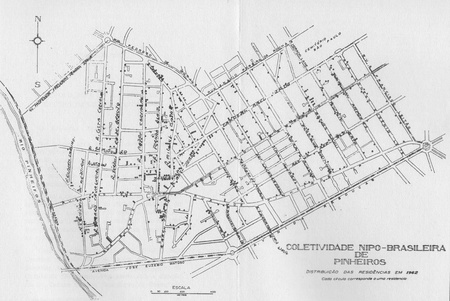
Mapa 5-2: A concentração de Nikkeis de Pinheiros vista pela distribuição das residências (1962) No mapa, os pontos pretos representam a residência de Nikkeis (Clique para aumentar) (AMARAL, Antonio B. do(1985)Pinheiros (3a. ed.) . São Paulo, DPH.)
Though the trend of Japanese enterprises advancing into Brazil had already started in the 1950s, the Yaohan Group, known for large-scale super markets, followed the second advancement trend and began business in Brazil in 1971. The first Yaohan Super Market was opened in Pinheiros. A Japanese monthly magazine in São Paulo commented on this event in this way.
In 1970, the company purchased land in downtown Pinheiros District of São Paulo city. The company flags, marked with a globe with “YAOHAN” printed over it, wave in the autumn breeze. The following year, January of 1971, (capital stock of 10 million cruzeiros) Yaohan Brasileira extravagantly opens its doors. And so, this Japanese, large scale super market became the center of attention in this industry. As hoped, Yaohan’s turnout is going smoothly. Various products are flying off the shelves and the popularity of the store is growing exponentially. Lines form in the morning before the store opens and the female staff line up at the front entrance in their light green uniforms to clap and embrace the entering customers with joy and gratitude. In this way, the Yaohan company system is operating according to plan.” (Gekkan Século, April of 1977, p.49)
However, though Yaohan successfully opened four branches within São Paulo city by 1976, due to the inflation after the oil shock of the following year, the company’s performance went into a slump and Yaohan quickly withdrew from Brazil. Cotia Industrial Association, formerly said to have been South America’s largest agricultural union, ended its 67 years of history in 1994.
Kiyoshi Mizumoto, one of the founding members of Casa Mizumoto, commented on the decline of the Pinheiros Japantown in a magazine interview in this way.
This town turned into such a run-down neighborhood so suddenly. It wasn’t so at the beginning. There was the Cotia Industrial Association, and Yaohan which came over from Japan, and the Nikkei who traveled to São Paulo from out of town would first come here to Pinheiros. There was so much fervor here, you know? Now, it’s truly, such a shame. (Viva! São Paulo, Ano II-No.5, June of 1996).
At the end of 2006, I walked around the Batata plaza area in the Pinheiros District. Today, the construction noise of the subway system on Av. Faria Lima resonates through the plaza. There is no end to the traffic of people and trains. One street further, on Rua Fernão Dias, lost in various other stores stand a Japanese restaurant and a Japanese-looking general store. Printed on the side of a warehouse are the words “Casa Ono” (Photo 5-2, 5-3). With the opening of the subway station here, the area will probably change once more. In this still-developing district, it seems the Pinheiros Japantown will only live on in the stories of the elderly Nikkei of the area.
© 2007 Sachio Negawa


